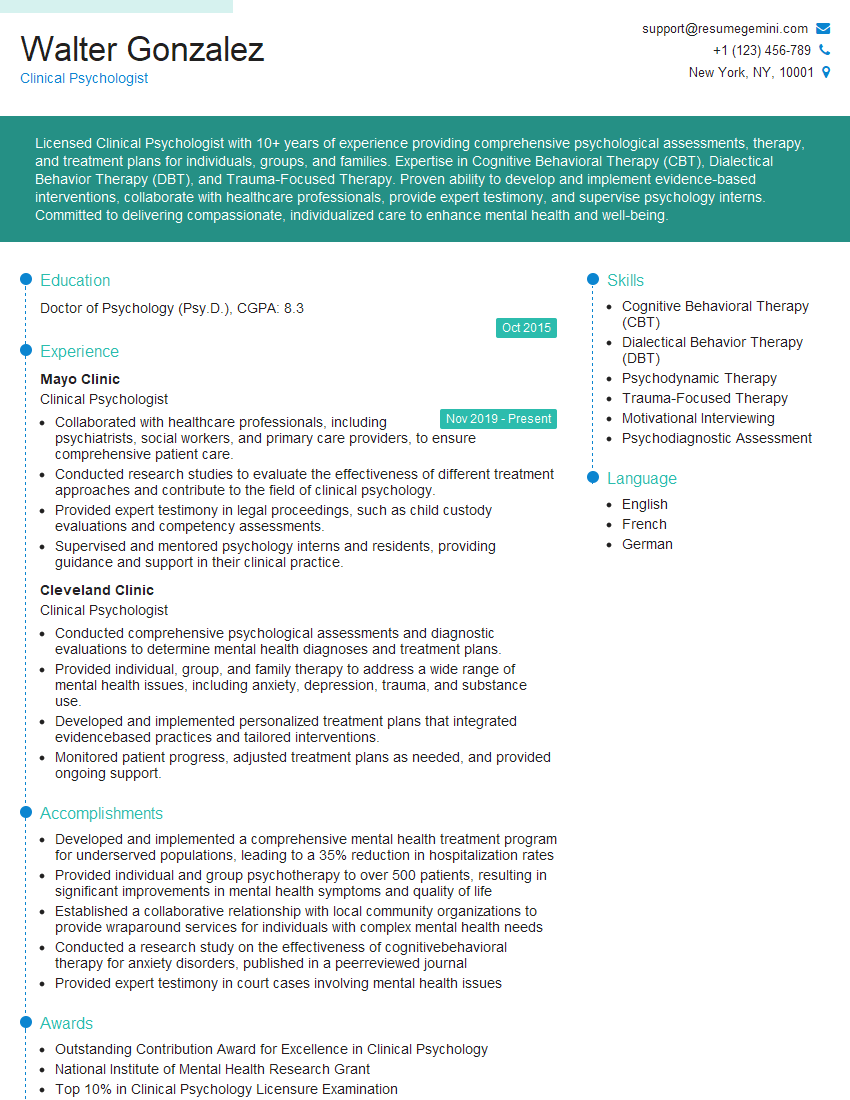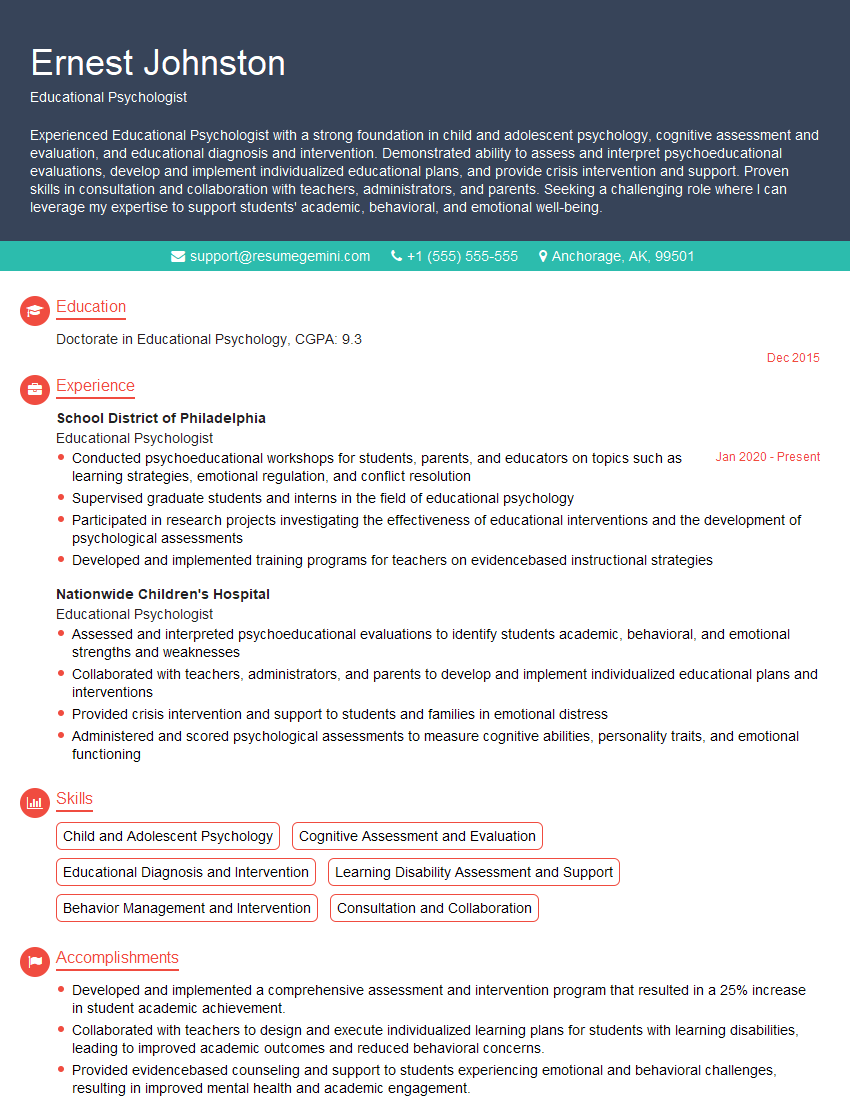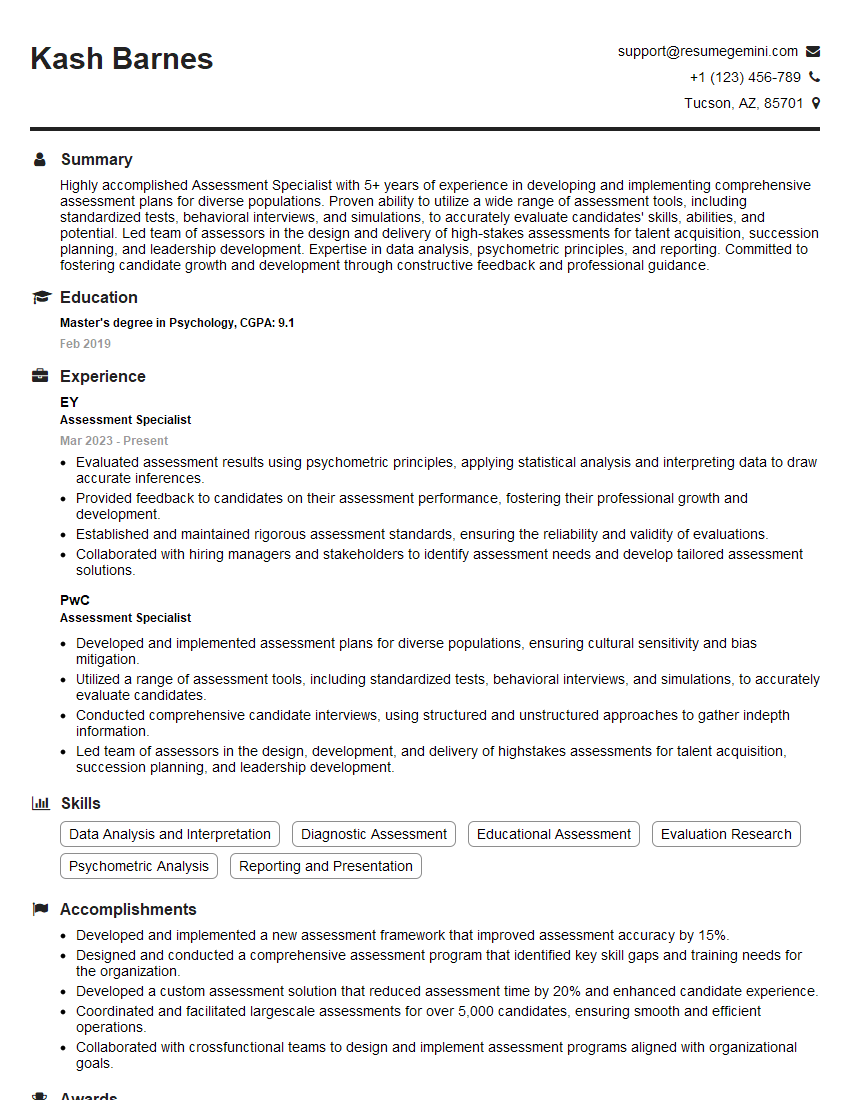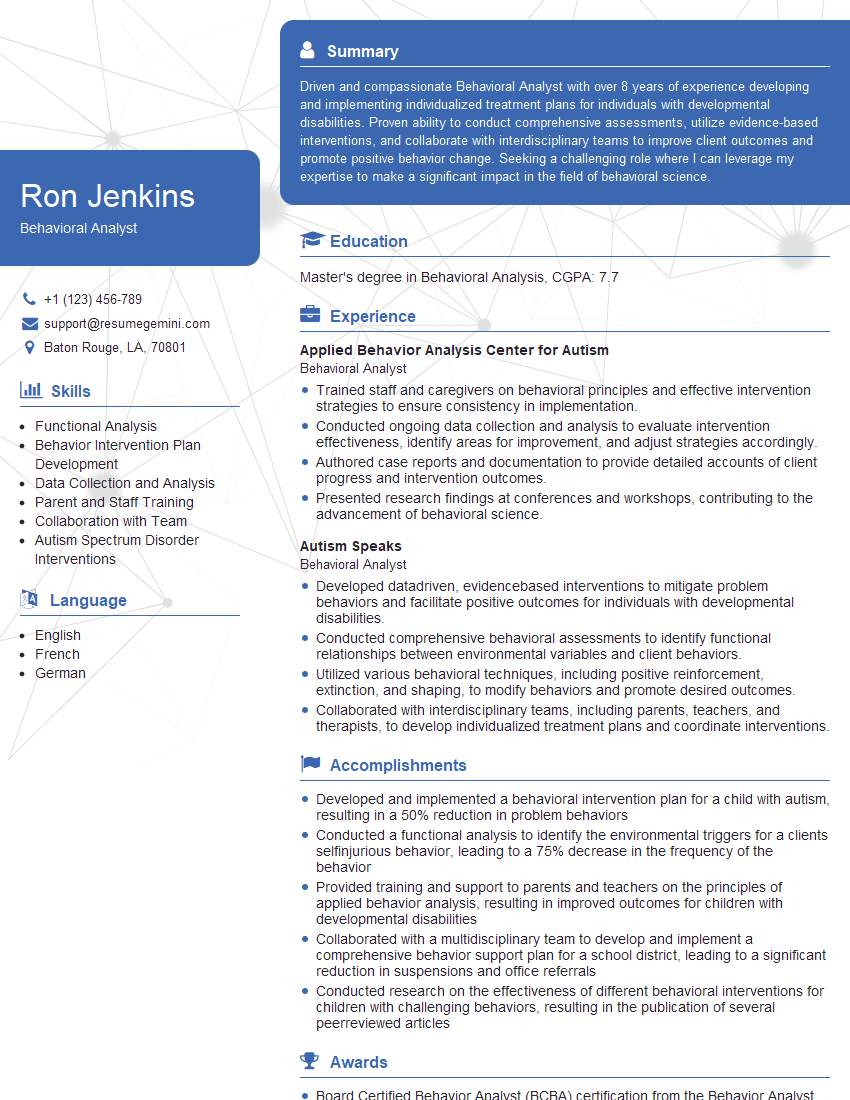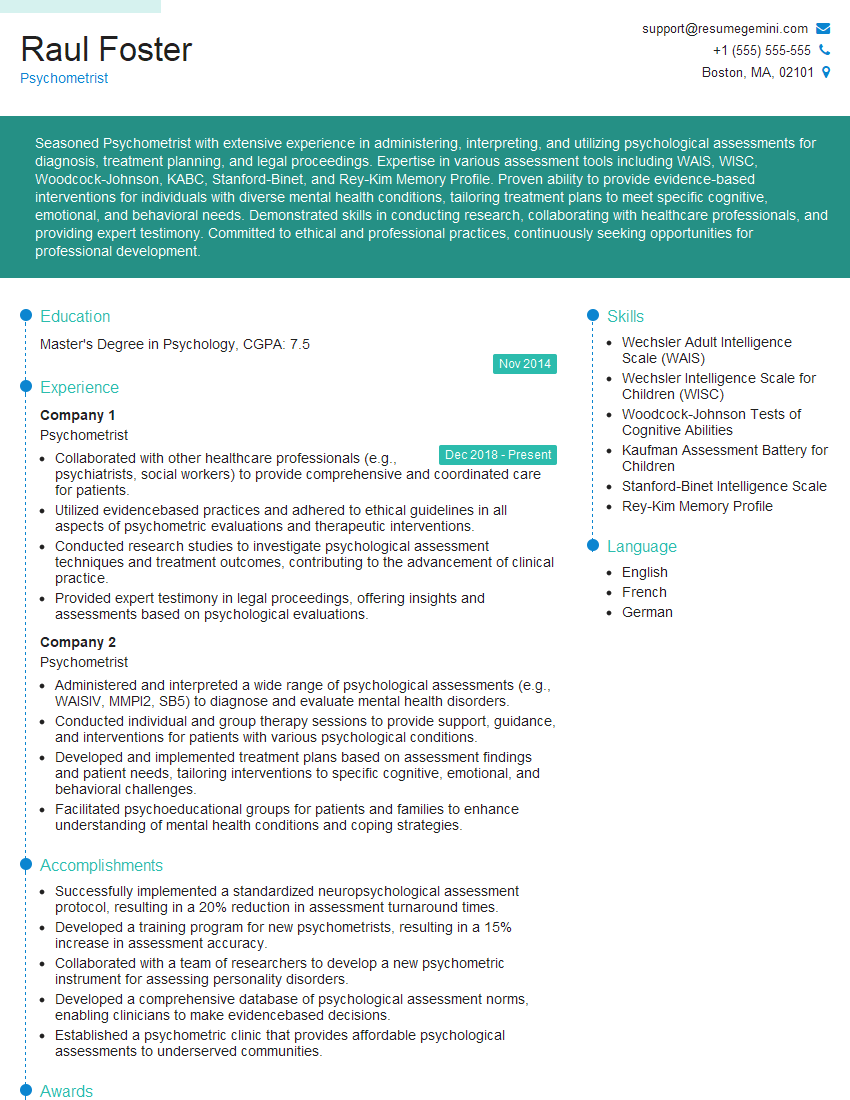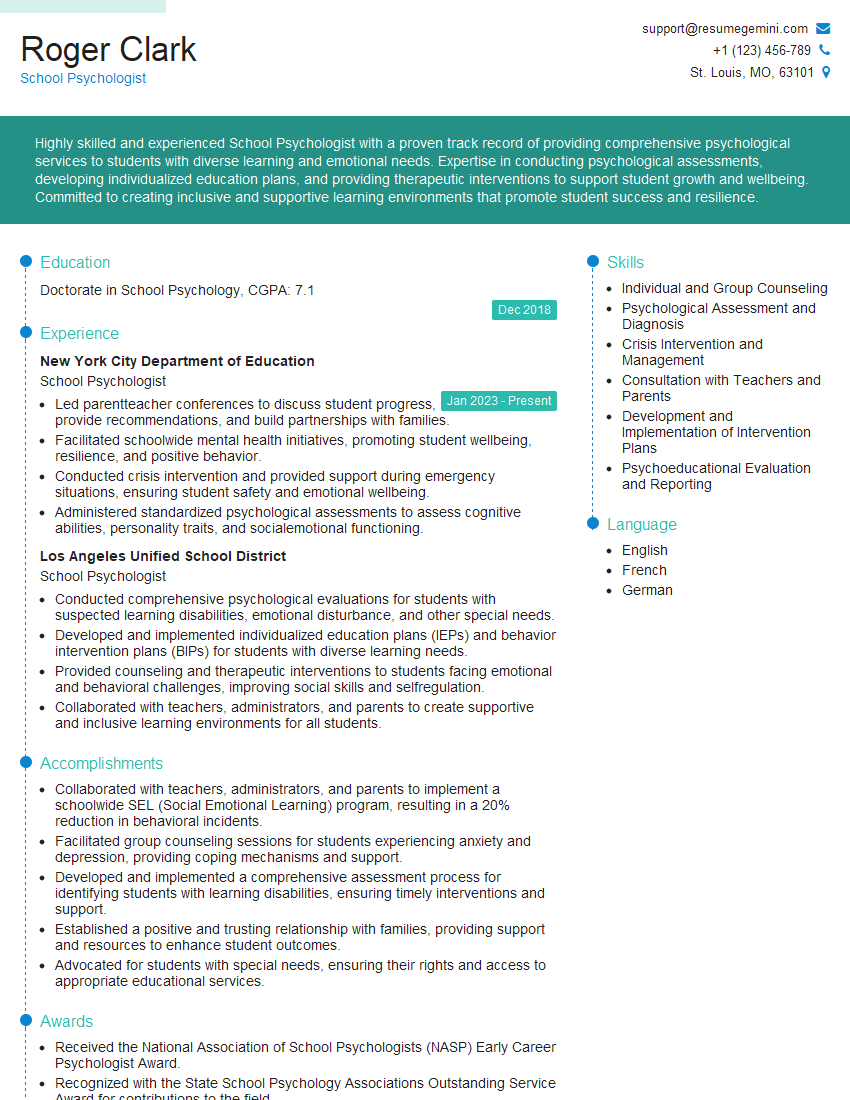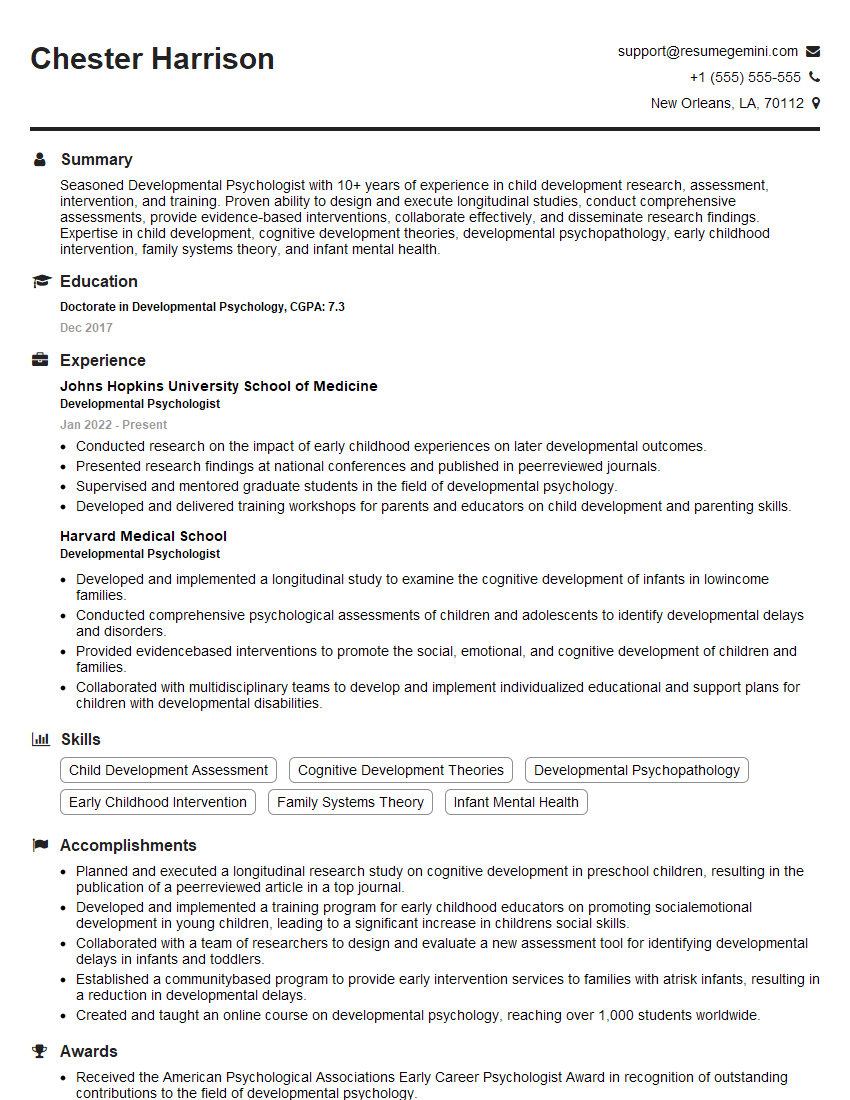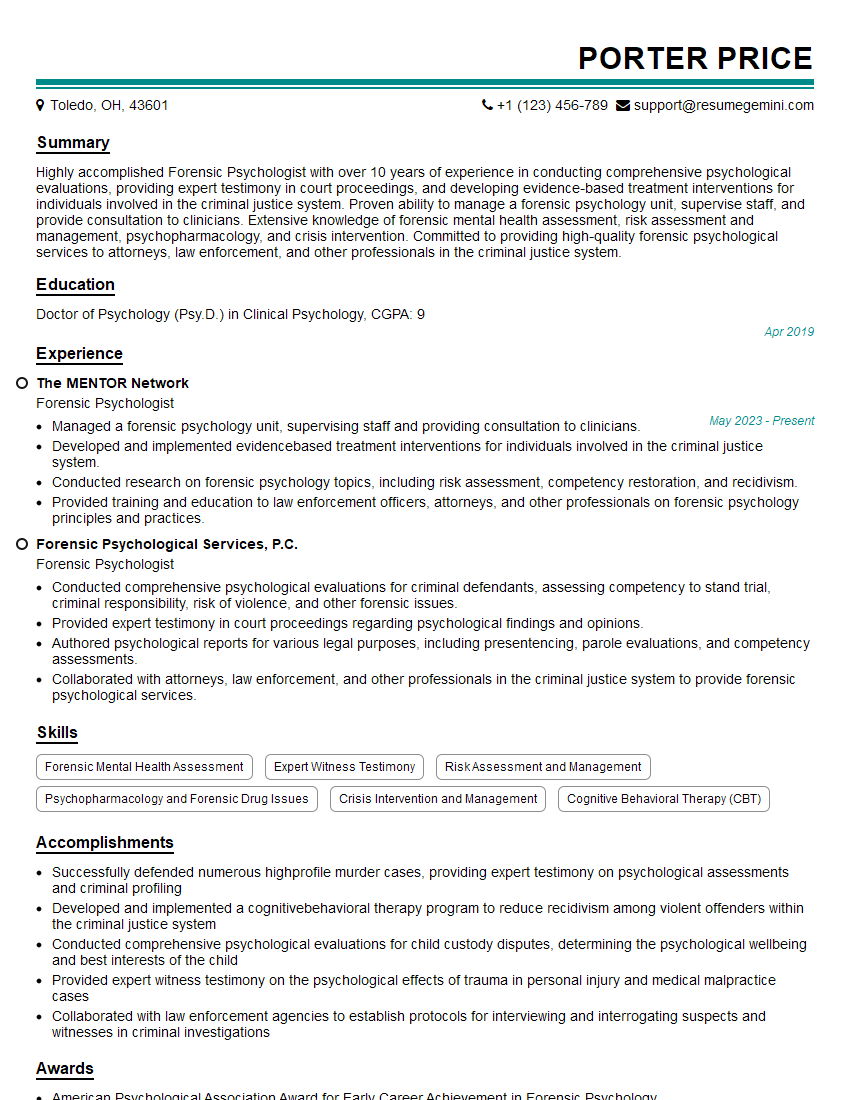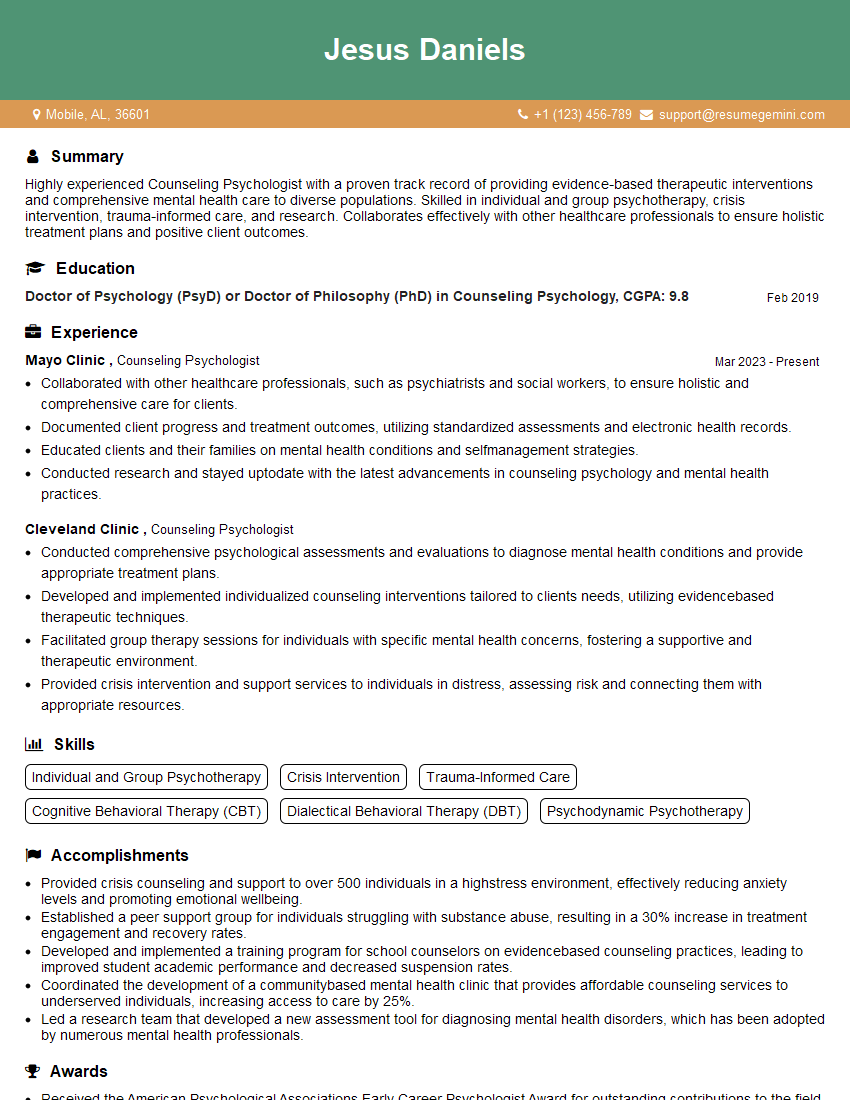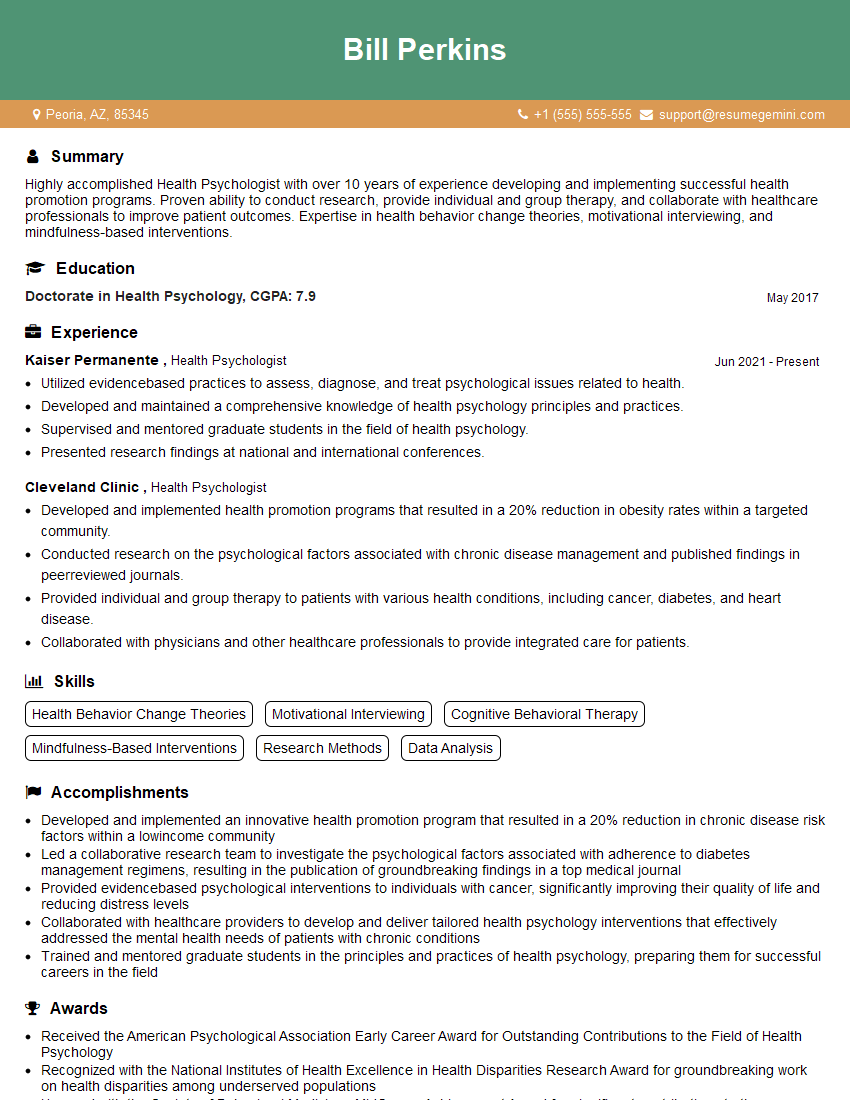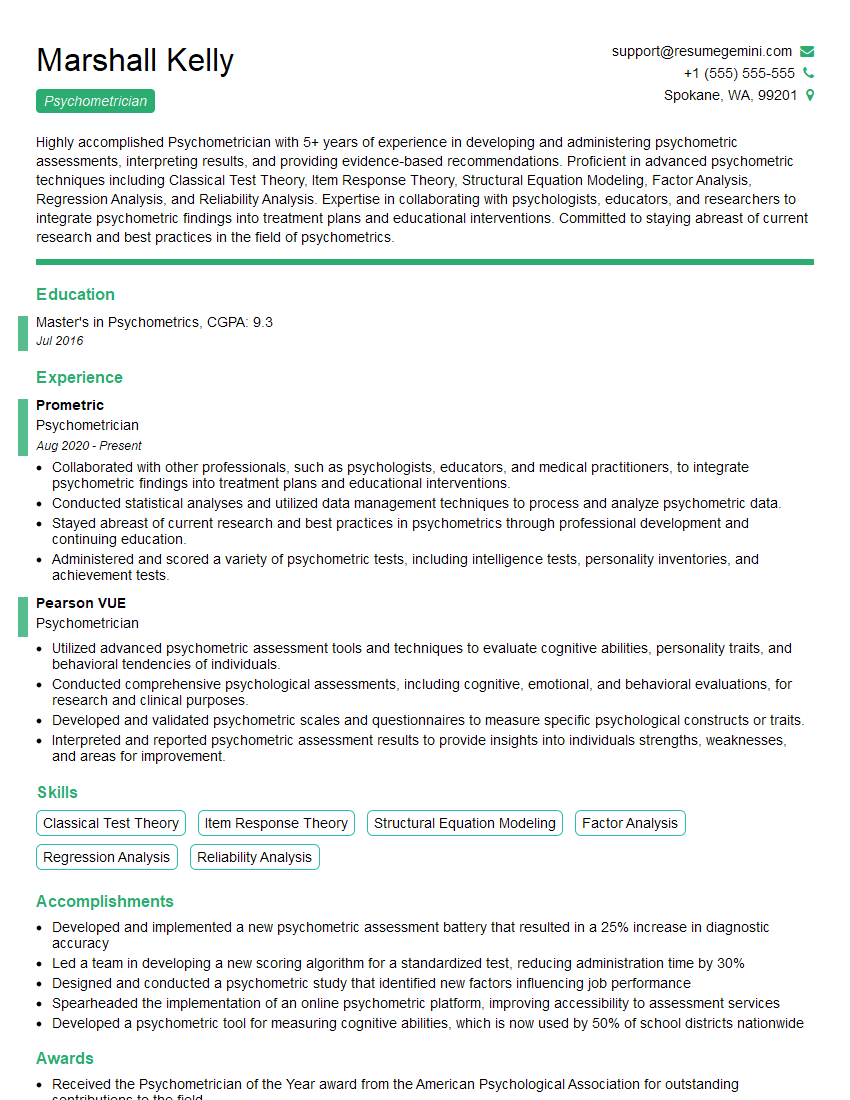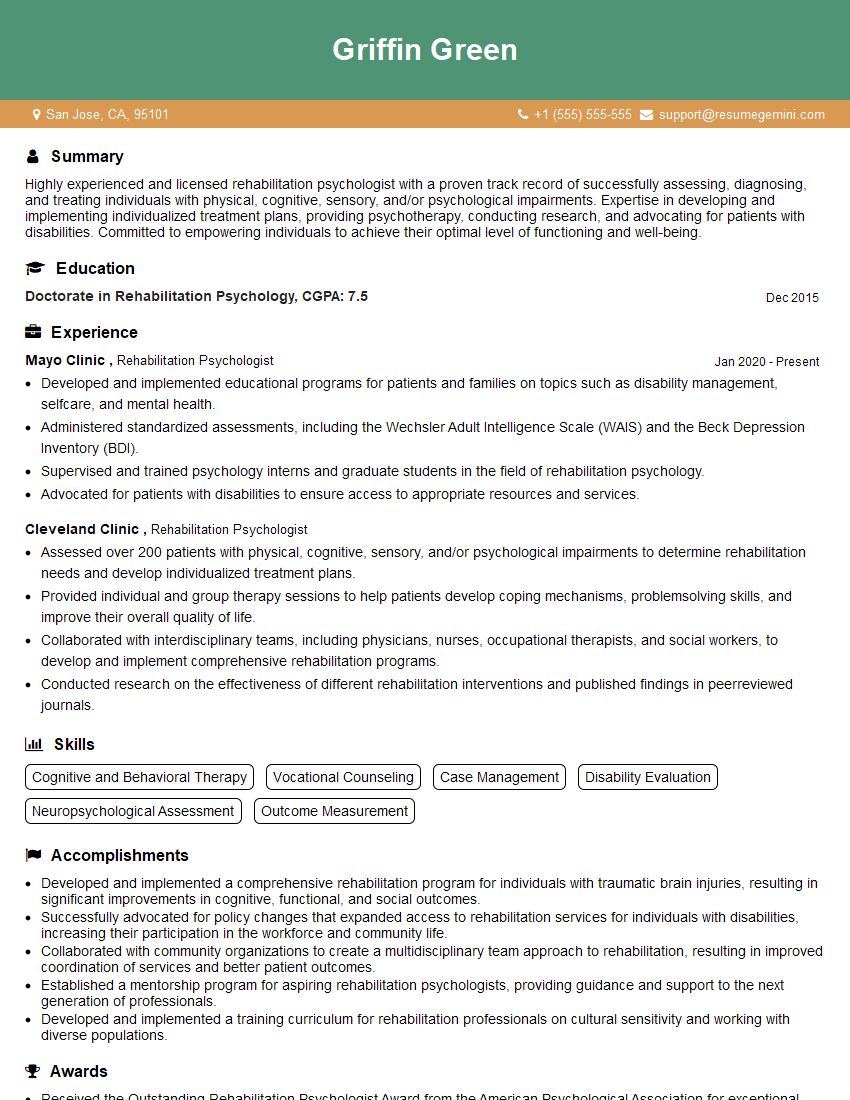The right preparation can turn an interview into an opportunity to showcase your expertise. This guide to Psychological Testing interview questions is your ultimate resource, providing key insights and tips to help you ace your responses and stand out as a top candidate.
Questions Asked in Psychological Testing Interview
Q 1. Describe the difference between norm-referenced and criterion-referenced tests.
The core difference between norm-referenced and criterion-referenced tests lies in how they interpret scores. A norm-referenced test compares an individual’s performance to that of a larger group, or norm group, who have already taken the test. Think of it like a race – your score is evaluated relative to how others performed. The goal is to identify where an individual falls on a distribution of scores, such as percentiles or standard scores. Examples include the Wechsler Adult Intelligence Scale (WAIS) and many personality inventories. These tests provide a comparative measure, revealing whether someone performs above, below, or at the average of the norm group.
In contrast, a criterion-referenced test measures an individual’s performance against a predetermined standard or criterion. The focus is not on comparison to others but rather on whether the individual has mastered specific skills or knowledge. Imagine a driving test – you pass or fail based on whether you meet specific driving criteria, not based on how well other drivers perform on the same test. Examples include achievement tests in schools, where students need to demonstrate mastery of certain concepts regardless of their peers’ performance.
Q 2. Explain the concept of test validity and its different types.
Test validity refers to how well a test measures what it claims to measure. It’s crucial for ensuring the accuracy and meaningfulness of the test results. There are several types of validity:
- Content Validity: Does the test comprehensively cover all aspects of the construct being measured? For example, a math test with content validity would cover all the relevant topics of the curriculum.
- Criterion Validity: Does the test accurately predict a relevant outcome or correlate with another established measure? This involves concurrent validity (correlation with a simultaneous measure) and predictive validity (ability to predict future outcomes). For instance, a good aptitude test might show concurrent validity by correlating strongly with current job performance and predictive validity by accurately forecasting future job success.
- Construct Validity: Does the test accurately measure the underlying theoretical construct it intends to measure? This is often assessed using factor analysis and involves evaluating convergent validity (correlation with similar measures) and discriminant validity (lack of correlation with dissimilar measures). A test measuring extraversion should correlate with other measures of sociability (convergent) but not with measures of anxiety (discriminant).
Establishing validity is an ongoing process involving both quantitative and qualitative evidence. It’s not simply a matter of one test, but rather accumulation of evidence from multiple sources to support the claim that the test indeed measures what it is designed to measure.
Q 3. What are the key considerations when selecting a psychological test for a specific purpose?
Selecting a psychological test requires careful consideration of several factors:
- Purpose of Assessment: What specific information is needed? Different tests are designed to assess different constructs (e.g., intelligence, personality, depression).
- Population Appropriateness: Is the test suitable for the age, cultural background, and language skills of the individual being assessed? Using a test designed for adults on a child would be inappropriate.
- Test Validity and Reliability: Has the test demonstrated strong evidence of validity and reliability? The test’s psychometric properties should be carefully examined before use.
- Test Administration and Scoring Procedures: Are the procedures clear, practical, and feasible given the resources available? Some tests may require specialized training to administer and interpret.
- Available Resources: Do you have the necessary resources (time, materials, training) to administer and interpret the test accurately?
- Ethical Considerations: Are there any ethical implications related to test usage, such as potential bias or invasion of privacy?
The selection process usually involves a thorough review of test manuals, research on the test’s psychometric properties, and consideration of the specific context of assessment.
Q 4. How do you ensure the reliability of test scores?
Ensuring the reliability of test scores is critical for confidence in the results. Reliability refers to the consistency of a test’s scores. Several methods are used to assess and enhance reliability:
- Test-Retest Reliability: Administering the same test to the same individuals at two different times and correlating the scores. High correlation indicates good test-retest reliability.
- Internal Consistency Reliability: Assessing the consistency of items within a single test administration. Cronbach’s alpha is a common statistic used to evaluate internal consistency. A higher alpha indicates greater internal consistency.
- Inter-Rater Reliability: Assessing the agreement between two or more raters who independently score the same test. High agreement indicates good inter-rater reliability. This is particularly relevant for tests involving subjective scoring.
Strategies to improve reliability include clear instructions, well-defined scoring criteria, and appropriate training for test administrators. The use of standardized procedures throughout the testing process is paramount for minimizing error variance and maximizing reliability.
Q 5. Explain the concept of standard error of measurement and its implications.
The standard error of measurement (SEM) quantifies the amount of error inherent in a test score. It represents the standard deviation of the distribution of hypothetical scores that an individual might obtain if they took the test multiple times under identical conditions. A smaller SEM indicates higher precision, meaning the observed score is a more accurate reflection of the individual’s true score.
Imagine shooting arrows at a target. The SEM represents the spread of the arrows around the bullseye. A small SEM indicates that the arrows are clustered closely together near the bullseye, suggesting greater accuracy. A large SEM means the arrows are scattered widely, indicating less precise measurements.
The SEM’s implications are significant: It helps establish a confidence interval around an obtained score, showing the range within which the true score likely lies. This helps interpret scores more cautiously, acknowledging the inherent error in measurement. Clinicians use the SEM to understand the degree of certainty associated with a test score and avoid overinterpreting minor score differences.
Q 6. Discuss the ethical considerations in administering and interpreting psychological tests.
Ethical considerations are paramount in psychological testing. Key ethical principles include:
- Informed Consent: Individuals must be fully informed about the purpose of the testing, how the information will be used, and their rights. They must provide voluntary consent.
- Confidentiality: Test results must be kept confidential and protected from unauthorized access. This includes securing test materials and adhering to relevant privacy regulations.
- Competence: Test administrators and interpreters must possess the necessary knowledge, skills, and training to administer, score, and interpret the test accurately.
- Cultural Sensitivity: Tests should be appropriate for the cultural background and language skills of the individuals being assessed, avoiding bias and ensuring fair representation.
- Test Security: Measures must be taken to prevent unauthorized access to test materials, which could compromise the validity and integrity of the tests.
- Appropriate Use of Tests: Tests should only be used for purposes for which they have been validated. It’s unethical to use a test to make decisions it is not designed to predict.
Ethical breaches can have severe consequences, affecting the client’s well-being and the professional reputation of the psychologist. Adherence to ethical guidelines ensures responsible and trustworthy practice.
Q 7. How do you handle test anxiety in a client during testing?
Test anxiety can significantly impact test performance. Addressing it requires a multi-faceted approach:
- Creating a Relaxing Environment: Ensure a comfortable and quiet testing environment to minimize distractions. Offer breaks if needed.
- Empathetic Approach: Acknowledge and validate the client’s anxiety. Explain the testing process clearly and reassuringly.
- Pre-Test Preparation: Provide information about the test, emphasizing the importance of trying one’s best and that it’s just one piece of information in the assessment process.
- Relaxation Techniques: Teach or encourage the use of relaxation techniques such as deep breathing or progressive muscle relaxation before and during the test, if appropriate and allowed by the test administration protocol.
- Positive Reinforcement: Offer encouragement and positive feedback throughout the testing process. Focus on effort and improvement rather than solely on the outcome.
- Consider Alternative Test Administration: If anxiety is severe, explore options like breaking up the testing into shorter sessions or using alternative formats if appropriate.
Remember to document all efforts made to address test anxiety and any modifications made during testing. It’s crucial to prioritize the client’s comfort and well-being while ensuring the integrity of the assessment process.
Q 8. Describe your experience with various types of psychological tests (e.g., intelligence, personality, neuropsychological).
My experience spans a wide range of psychological tests, encompassing intelligence, personality, and neuropsychological assessments. In the realm of intelligence testing, I’m proficient with the Wechsler Adult Intelligence Scale (WAIS), the Stanford-Binet Intelligence Scales, and the Kaufman Assessment Battery for Children (KABC). These tests help assess cognitive abilities like verbal comprehension, perceptual reasoning, and working memory. With personality assessments, I’ve worked extensively with the Minnesota Multiphasic Personality Inventory (MMPI-2-RF), the NEO PI-R, and the Big Five Inventory, gaining valuable insight into personality traits, emotional functioning, and psychopathology. Finally, my neuropsychological assessment experience involves administering and interpreting tests such as the Halstead-Reitan Neuropsychological Battery and the Luria-Nebraska Neuropsychological Battery, which help evaluate cognitive deficits following brain injury or neurological disorders.
For example, I recently used the WAIS-IV to assess a client experiencing cognitive difficulties following a concussion. The results helped pinpoint specific areas of weakness, guiding subsequent therapy and rehabilitation. In another case, the MMPI-2-RF was crucial in understanding the underlying personality factors contributing to a patient’s anxiety and depression, informing treatment planning.
Q 9. What statistical methods are commonly used in psychological testing?
Statistical methods are essential for analyzing data from psychological tests. Commonly used techniques include:
- Descriptive Statistics: Mean, median, mode, standard deviation, and percentiles are used to summarize and describe test scores.
- Inferential Statistics: t-tests, ANOVAs, and correlation analysis are used to examine relationships between variables and draw conclusions about populations based on sample data. For example, a t-test might compare the average scores of two groups on a depression inventory.
- Reliability Analysis: Cronbach’s alpha and test-retest reliability are crucial for determining the consistency and stability of test scores over time and across different items.
- Validity Analysis: Techniques like factor analysis (discussed in the next question), criterion-related validity (e.g., correlating test scores with external criteria), and content validity are used to assess whether the test measures what it intends to measure.
- Item Response Theory (IRT): IRT models are increasingly used to analyze individual item performance and to develop more precise and efficient tests.
Understanding these methods is vital for interpreting test results accurately and making sound clinical judgments.
Q 10. Explain the concept of factor analysis in test development.
Factor analysis is a statistical technique used in test development to identify underlying latent variables (factors) that explain the correlations among observed variables (test items). It helps to reduce the complexity of a large number of test items into a smaller set of meaningful factors. Imagine a personality questionnaire with numerous items. Factor analysis helps us determine if those items cluster together to represent broader personality traits, such as extraversion, neuroticism, or openness to experience.
How it works: Factor analysis examines the correlation matrix of test items. Items that correlate highly with each other are likely measuring the same underlying factor. Different extraction methods (e.g., principal components analysis, maximum likelihood) can be used, followed by rotation techniques (e.g., varimax, oblimin) to improve the interpretability of the factors. The result is a smaller number of factors, each with its own set of items, that explain a significant portion of the variance in the original data. This process aids in creating more efficient and focused tests, removing redundant items, and clarifying the construct being measured.
For example, in developing a new anxiety measure, factor analysis might reveal that many items related to worry, nervousness, and physical symptoms load onto a single factor, representing generalized anxiety. This helps refine the test and ensures that it’s measuring a cohesive construct.
Q 11. How do you interpret and communicate test results to clients or other professionals?
Interpreting and communicating test results requires sensitivity, clarity, and a strong understanding of the test’s limitations. I always begin by explaining the purpose of the testing and the overall context of the findings in a way that’s easily understood by the client (or referring professional). I avoid using technical jargon and utilize clear, concise language to describe the results, focusing on what the scores mean in practical terms rather than just presenting raw numbers.
For example, instead of saying “Your score on the depression scale is 22,” I might explain, “Your score suggests that you are experiencing a significant level of depressive symptoms, which are impacting your daily functioning in these specific areas…” I would then discuss potential implications of the results, considering other factors in the client’s life, and collaboratively formulate recommendations for treatment or further assessment. When communicating with other professionals, I maintain a similar approach but include more detailed statistical information and clinical reasoning.
Confidentiality is paramount. Results are always shared only with authorized individuals, and I meticulously maintain client records according to ethical guidelines and legal regulations. The goal is to empower clients with information to make informed decisions about their well-being.
Q 12. Describe your experience with test adaptation or translation.
My experience with test adaptation and translation involves a thorough understanding of psychometric principles and cultural nuances. Simply translating a test from one language to another is insufficient; it requires careful consideration of cultural equivalence. This includes ensuring that the test items are understood and interpreted similarly across different cultures and that the scoring and norms are appropriate for the target population.
The process involves several steps: translation by multiple bilingual professionals, back-translation to verify accuracy, cognitive debriefing with members of the target population to assess comprehension and relevance, and pilot testing to evaluate the psychometric properties in the new cultural context. Addressing potential biases and ensuring fairness across groups is crucial to maintain the validity and reliability of the adapted test. I’ve been involved in adapting several assessment measures for use with Hispanic and Asian populations, carefully navigating the complexities of linguistic and cultural variations.
Q 13. Discuss your experience working with diverse populations.
Working with diverse populations is a crucial aspect of my practice. I recognize that cultural background, socioeconomic status, gender identity, and other demographic factors can significantly influence test performance and interpretation. To effectively work with diverse populations, I strive to create a culturally sensitive and inclusive environment. This involves understanding potential biases embedded in the tests themselves and accounting for cultural differences in communication styles and behaviors.
For instance, I use culturally sensitive language and employ appropriate communication strategies to build rapport and trust. I also use interpreters when necessary and consider using tests that have been specifically validated for the specific cultural group being assessed. It is also imperative to account for potential differences in response styles and examine if a client’s performance is impacted by social desirability or other factors beyond the construct being measured.
Furthermore, I’m aware of the importance of cultural humility, actively seeking ongoing education and cultural consultation when working with clients from backgrounds different from my own.
Q 14. How do you ensure test security and confidentiality?
Ensuring test security and confidentiality is paramount. I strictly adhere to professional ethical guidelines and legal regulations in protecting the integrity of psychological tests and the privacy of clients. This includes:
- Secure Storage: Tests and related materials are stored in locked cabinets or secure electronic systems, limiting access to authorized personnel only.
- Controlled Administration: Tests are administered in private, controlled settings to minimize the risk of cheating or compromising results.
- Confidentiality Policies: I maintain strict confidentiality concerning test results, releasing information only with the client’s informed consent or as required by law.
- Data Protection: Digital data are protected with strong passwords and encryption techniques, complying with all relevant data protection regulations.
- Ethical Disposal: Used test materials are disposed of securely, preventing unauthorized access or misuse.
By upholding these security measures, I protect the validity of the tests and the trust placed in me by my clients.
Q 15. What are the limitations of psychological tests?
Psychological tests, while valuable tools, possess inherent limitations. It’s crucial to remember they are not infallible measures of a person’s complete psychological state. These limitations fall broadly into several categories:
- Test Construction Bias: The way a test is designed can inadvertently favor certain groups or perspectives, leading to inaccurate or unfair results. For example, a test heavily reliant on verbal fluency might disadvantage individuals from cultures where quiet observation is valued.
- Sampling Error: The test’s validity depends on the sample group used in its development. If the sample doesn’t accurately represent the population it aims to assess, the results will be skewed.
- Situational Factors: A person’s performance on a test can be heavily influenced by external factors such as stress, fatigue, or the testing environment. A noisy room or a rushed testing period can affect scores.
- Response Bias: Test-takers can consciously or unconsciously distort their responses, either to present themselves in a positive light (social desirability bias) or to intentionally sabotage the results.
- Subjectivity in Interpretation: Even with standardized tests, some degree of professional judgment is needed during interpretation. Two clinicians might draw slightly different conclusions from the same test data, emphasizing the need for careful consideration and cross-referencing.
- Limited Scope: No single test can capture the full complexity of human personality or mental health. Tests often measure specific aspects of a person’s psychological functioning, and should be considered just one piece of a larger clinical picture.
Understanding these limitations is vital for responsible and ethical test usage. It requires clinicians to interpret results cautiously, taking into account the context and employing multiple assessment methods to build a comprehensive understanding.
Career Expert Tips:
- Ace those interviews! Prepare effectively by reviewing the Top 50 Most Common Interview Questions on ResumeGemini.
- Navigate your job search with confidence! Explore a wide range of Career Tips on ResumeGemini. Learn about common challenges and recommendations to overcome them.
- Craft the perfect resume! Master the Art of Resume Writing with ResumeGemini’s guide. Showcase your unique qualifications and achievements effectively.
- Don’t miss out on holiday savings! Build your dream resume with ResumeGemini’s ATS optimized templates.
Q 16. How do you address cultural biases in psychological testing?
Addressing cultural biases in psychological testing is paramount for ensuring fairness and accuracy. It’s not simply about translation; it’s about understanding the cultural context of the test and its implications. Here’s how I approach this challenge:
- Test Adaptation: Direct translation isn’t always sufficient. Tests need to be adapted to reflect the cultural norms, values, and experiences of the target population. This involves carefully reviewing items for culturally specific content and potentially modifying or replacing them with culturally equivalent items.
- Use of Culturally Relevant Tests: Where possible, I prioritize using tests that have been specifically designed or validated for the cultural group being assessed. There are a growing number of culturally sensitive measures available.
- Careful Interpretation of Results: Even with adapted tests, interpreting results requires sensitivity to cultural factors. A score might be lower not because of an underlying deficiency but because of cultural differences in communication styles or response patterns.
- Consideration of Socioeconomic Factors: Socioeconomic status can significantly impact test performance. Account for potential influences of access to education, healthcare, and other resources.
- Ongoing Research and Review: The field constantly evolves. I stay up-to-date with research on culturally appropriate assessment and continually evaluate the cultural validity of the tests I use.
For example, a test measuring self-esteem that relies heavily on individualistic notions of success might not be appropriate for collectivist cultures where group harmony is prioritized. By understanding these nuances, we can create a more just and equitable testing process.
Q 17. Describe your experience using specific software for psychological testing and data analysis (e.g., SPSS, R).
Throughout my career, I’ve extensively used SPSS and R for psychological testing and data analysis. SPSS provides a user-friendly interface for performing a wide range of statistical analyses, particularly helpful for managing large datasets and conducting analyses such as t-tests, ANOVAs, and correlations. I regularly use SPSS to analyze data from standardized personality inventories, such as the MMPI-2-RF, and to explore relationships between test scores and other variables, like demographic factors or clinical symptoms.
R, on the other hand, offers greater flexibility and control, particularly when dealing with more complex statistical models or specialized analyses. I use R to perform factor analysis, creating scales and evaluating the dimensionality of the tests I use. Its open-source nature and vast library of packages also make it valuable for creating custom analyses and visualizations tailored to specific research questions. For instance, I’ve used R to build predictive models leveraging machine learning techniques to identify individuals at risk for specific mental health conditions based on their test performance.
Here’s a simple example of R code for calculating a correlation in R:
cor(dataset$test_score, dataset$age)This code calculates the Pearson correlation between ‘test_score’ and ‘age’ variables in a dataset named ‘dataset’.
Q 18. Explain the process of developing a new psychological test.
Developing a new psychological test is a rigorous and multifaceted process that requires expertise in psychometrics, clinical psychology, and research methodology. It’s not a quick undertaking; it involves multiple phases:
- Test Conceptualization: This phase defines the construct the test aims to measure and clearly outlines its intended purpose and target population. A thorough literature review and theoretical framework are essential.
- Item Generation: Once the construct is defined, items (questions or tasks) are developed to tap into different facets of the construct. This often involves generating a large pool of items to ensure a variety of perspectives.
- Pilot Testing: The initial version of the test is administered to a small sample to evaluate its clarity, feasibility, and preliminary psychometric properties (e.g., item difficulty). Feedback is collected for revisions.
- Test Revision: Based on pilot test results, items are refined, revised, or eliminated to improve the test’s clarity, relevance, and psychometric soundness.
- Normative Sample: The revised test is administered to a large and representative sample of the target population. This provides the data needed to establish norms and statistical parameters.
- Psychometric Analysis: This crucial step involves statistical analysis to evaluate the test’s reliability (consistency) and validity (accuracy). Techniques such as factor analysis, internal consistency reliability (Cronbach’s alpha), and test-retest reliability are employed.
- Test Standardization: Once the psychometric properties are established, the test is standardized by creating detailed instructions for administration and scoring, ensuring consistent application across various settings.
- Publication and Dissemination: The final test, including detailed manuals and normative data, is typically published and disseminated to professionals.
Throughout this process, ethical considerations, such as test fairness and cultural sensitivity, must be prioritized. Rigorous testing and evaluation ensure the validity and reliability of the new assessment.
Q 19. How do you stay current with the latest developments in psychological testing?
Staying current in the rapidly evolving field of psychological testing involves a multi-pronged approach:
- Professional Journals: I regularly read leading journals such as the Journal of Consulting and Clinical Psychology, Psychological Assessment, and Assessment to stay informed about new research, test developments, and methodological advancements.
- Professional Organizations: Active membership in organizations like the American Psychological Association (APA) provides access to conferences, workshops, and continuing education opportunities that cover the latest trends and innovations in the field.
- Conferences and Workshops: Attending conferences and workshops is invaluable for networking with colleagues and learning about cutting-edge research and best practices. These events allow for direct interaction with leading experts.
- Continuing Education: I actively seek opportunities for continuing education to maintain and enhance my skills in psychological assessment and data analysis.
- Online Resources: Credible online resources and databases, such as PsycINFO and PubMed, are used for accessing research articles and staying updated on new literature.
By combining these strategies, I maintain a strong foundation of knowledge and ensure my practice remains aligned with current standards and best practices.
Q 20. Describe a situation where you had to interpret ambiguous test results.
I recall a case where a patient presented with highly contradictory results on a personality inventory and a projective test (the Rorschach). The personality inventory suggested high levels of anxiety and depression, whereas the Rorschach indicated significant levels of repression and defensiveness, potentially masking underlying emotional distress. This ambiguity required a multi-faceted approach to interpretation.
To resolve this, I first reviewed the testing conditions, ensuring there were no factors (like fatigue or discomfort) that might have impacted performance on either test. I then engaged in further clinical interviews, focusing on exploring the inconsistencies between the self-report data and the projective data. This allowed me to understand if certain life circumstances might have caused this apparent discrepancy or the possible presence of a defense mechanism to protect against extreme emotional turmoil. Ultimately, I integrated both sets of results with other clinical information (patient history, observations, and collateral information) to create a more nuanced understanding of the patient’s emotional state and form a comprehensive treatment plan.
This experience reinforced the importance of utilizing multiple assessment methods and the value of clinical judgment when working with ambiguous test results. Relying solely on one test’s findings would have likely provided an incomplete and potentially misleading picture.
Q 21. How do you handle situations where test results conflict with clinical observations?
Discrepancies between test results and clinical observations are common and require a thoughtful and systematic approach. I’ve encountered several such situations where the test scores didn’t align perfectly with my impressions during clinical interaction.
My approach is structured as follows:
- Re-evaluation of the Test Administration: The first step is to critically examine the circumstances under which the test was administered. Were there any factors that may have compromised the validity of the test results (e.g., distractions, lack of rapport, misunderstanding of instructions)?
- Review of the Clinical Observations: I carefully reassess my clinical observations, ensuring they are well-documented and reflect my accurate and objective assessment of the patient’s verbal and non-verbal communication, behavior, and presentation.
- Exploration of Possible Explanations: Next, I explore potential reasons for the discrepancy. Are there defense mechanisms at play? Could there be cultural or situational factors influencing either the test scores or my clinical impressions? Could the test itself be inadequate for assessing this particular individual or presenting clinical picture?
- Integration of Multiple Data Sources: I integrate the test data with all other available information—clinical interviews, collateral information from family members or other professionals, and relevant medical history—to create a comprehensive picture.
- Further Assessment: If the discrepancy remains unresolved, further assessment may be necessary. This could involve additional testing, further clinical interviews, or consultation with other professionals.
The goal is not to simply dismiss either the test results or clinical observations but to carefully consider all the information, determine the most plausible explanations for the discrepancy, and ultimately arrive at an informed and integrated understanding of the individual’s psychological functioning. This ensures a responsible and evidence-based treatment plan.
Q 22. What are the legal and professional guidelines you follow when conducting psychological testing?
Adhering to legal and professional guidelines is paramount in psychological testing. This ensures ethical practice, protects client rights, and maintains the validity of the results. These guidelines are multifaceted and encompass several key areas:
- Confidentiality: All client information obtained through testing is strictly confidential and protected under relevant laws like HIPAA (in the US) and similar regulations in other countries. This includes securely storing test data, limiting access to authorized personnel only, and obtaining explicit consent before disclosing any information to third parties. For example, I would never discuss a client’s test results with their employer without their informed consent.
- Competence: I only administer and interpret tests within my area of expertise. Using a test I’m not qualified to interpret would be a serious breach of professional ethics. I regularly update my knowledge on best practices and new developments in the field.
- Informed Consent: Clients must fully understand the purpose, procedures, and potential implications of the testing before consenting. This includes explaining the types of tests used, how long it will take, and what the results might be used for. I take great care to ensure clients understand they can withdraw at any time.
- Test Security: Maintaining the integrity of test materials is crucial. This means storing tests securely, following instructions for administration precisely, and preventing unauthorized access or reproduction of test materials. This is essential to ensure that the test results are valid and not compromised.
- Cultural Sensitivity: I am acutely aware of the potential impact of cultural biases on testing and strive to utilize culturally appropriate measures whenever possible. This may involve selecting tests that are culturally fair and using interpretation strategies that acknowledge diverse backgrounds and experiences.
- Legal and Ethical Reporting: Test results are reported accurately, clearly and in a way that is understandable to the recipient (e.g., the client, referring physician, etc.). This also includes being mindful of legal requirements for reporting any findings that suggest harm to the client or others. For instance, if a client expresses suicidal ideation, I am obligated to take appropriate steps to ensure their safety.
Failure to adhere to these guidelines can lead to disciplinary action, legal repercussions, and harm to the client. Ethical and legal compliance is not merely a checklist; it’s an ongoing commitment to responsible practice.
Q 23. Explain the importance of informed consent in psychological testing.
Informed consent is the cornerstone of ethical psychological testing. It’s more than just a signature on a form; it’s a process that ensures the client understands the testing process and willingly participates. Without it, the testing is invalid and potentially unethical.
Importance:
- Autonomy: Informed consent upholds the client’s right to self-determination. They are empowered to make informed decisions about their participation.
- Transparency: It ensures transparency about the purpose, procedures, potential risks and benefits, and limitations of the testing. For instance, I explain that the tests provide insights but aren’t definitive diagnoses.
- Trust: It builds trust and rapport between the client and the psychologist, creating a safe and collaborative environment.
- Legal Protection: Obtaining informed consent protects both the psychologist and the client from potential legal issues.
The Process: I typically start by explaining the reasons for the testing in language the client understands. I outline the types of tests to be used, explaining the process in simple terms, avoiding jargon. I clearly articulate the limitations of the tests and emphasize that they are tools to aid in understanding, not definitive answers. I then explain how the results will be used and with whom they may be shared. Only after addressing all questions and ensuring the client fully understands do I proceed with obtaining their consent. The entire process is documented.
Q 24. Describe your experience with different scoring methods for psychological tests.
My experience encompasses a wide range of scoring methods for various psychological tests. Scoring methods vary depending on the test’s design and purpose. Some tests use:
- Raw Scores: These are the initial, unadjusted scores directly from the test. For example, the number of correct answers on an achievement test.
- Standard Scores: These scores transform raw scores to a standard distribution (e.g., z-scores, T-scores). This allows for comparison across different tests and facilitates interpretation. For example, a T-score of 60 is one standard deviation below the mean.
- Percentile Ranks: These indicate the percentage of individuals in a normative sample who scored at or below a given score. A percentile rank of 75 means the individual scored higher than 75% of the normative sample.
- Developmental Scores: These are used in tests assessing cognitive or motor development (e.g., age equivalents, developmental quotients). These scores indicate performance relative to typical development at a given age.
- Criterion-Referenced Scores: These scores compare an individual’s performance to a specific criterion or standard. For example, a student might score above a threshold indicating mastery of a particular skill.
I am proficient in using both manual and computer-assisted scoring methods. Computer-assisted scoring software often provides detailed reports, including normative data and interpretive statements. However, I always carefully review the computer-generated reports and use my clinical judgment to interpret the results within the broader context of the client’s situation. I never rely solely on automated interpretations.
Q 25. How do you maintain the objectivity and integrity of the testing process?
Maintaining objectivity and integrity in the testing process is crucial. This involves a multi-pronged approach:
- Standardized Administration: I meticulously follow the standardized instructions for each test to ensure consistency and comparability of results. This includes adhering to time limits, presenting instructions verbatim, and maintaining a neutral demeanor.
- Objective Scoring: I use objective scoring methods whenever possible, minimizing subjective judgment. I double-check my scoring to reduce errors. If there are subjective components, I use clear scoring guidelines to minimize bias.
- Minimizing Bias: I am aware of the potential for bias in both test design and interpretation and take steps to mitigate its impact. This includes choosing culturally appropriate tests and considering the client’s background and experiences when interpreting results. For example, I’d be mindful of potential language barriers or cultural differences that might affect test performance.
- Regular Calibration: I regularly review my scoring practices and compare them to those of other professionals to ensure consistency. I attend workshops and keep up-to-date on best practices.
- Record Keeping: I meticulously document all aspects of the testing process, including the tests administered, the date and time of testing, the scoring, and the interpretations. Detailed records are essential for ensuring accountability and traceability.
Objectivity doesn’t mean eliminating clinical judgment entirely. It means using systematic approaches to reduce the influence of personal biases and ensuring that interpretations are grounded in empirical evidence and professional standards.
Q 26. What are some common pitfalls to avoid when interpreting psychological test results?
Interpreting psychological test results requires careful consideration and awareness of potential pitfalls. Some common errors to avoid include:
- Over-reliance on a single test: It’s crucial to consider multiple sources of information, including interviews, observations, and other assessments. A single test provides only a partial picture.
- Ignoring contextual factors: Test results should be interpreted in light of the client’s background, cultural experiences, and current life circumstances. For example, a low score on a mood scale may be understandable given a recent traumatic event.
- Misunderstanding statistical concepts: A clear understanding of statistical concepts, such as standard deviations and confidence intervals, is essential for accurate interpretation.
- Confirmation bias: Allowing pre-existing beliefs or expectations to influence the interpretation of test data.
- Overgeneralization: Applying test findings inappropriately to other areas of the client’s life.
- Ignoring base rates: Failing to consider the prevalence of a particular trait or condition in the general population.
- Labeling the client: Focusing on the diagnosis instead of understanding the person’s strengths and challenges.
To avoid these pitfalls, I maintain a critical and reflective approach to interpretation. I regularly consult with colleagues, utilize resources such as textbooks and professional journals, and stay current on best practices to enhance my skill in interpreting tests.
Q 27. Describe your approach to providing feedback to clients after administering a psychological test.
Providing feedback to clients after psychological testing is a crucial and sensitive process. My approach prioritizes clarity, empathy, and collaboration.
Process:
- Scheduling a dedicated session: Feedback is not given casually; it’s delivered during a separate session, allowing ample time for discussion.
- Using plain language: I avoid technical jargon and explain findings in a clear, straightforward manner tailored to the client’s understanding. Analogies and examples help to illustrate complex concepts.
- Focusing on strengths and weaknesses: I present both strengths and areas for potential growth, offering a balanced perspective.
- Collaboratively framing the results: The session is a collaborative process; I don’t simply deliver results but work with the client to understand the implications and develop strategies for improvement.
- Empathetic listening: I create a safe space for the client to express their feelings and address concerns.
- Answering questions thoroughly: I am prepared to answer any questions the client has.
- Developing an action plan (if applicable): Depending on the purpose of the testing, I may collaboratively develop an action plan to address any identified challenges.
The feedback session is not just about delivering results; it’s about empowering the client with knowledge and tools for personal growth. I aim to leave the client feeling understood, supported, and hopeful.
Q 28. How do you ensure that the testing environment is conducive to accurate results?
Creating a conducive testing environment is critical to obtaining accurate and reliable results. Factors influencing this environment include:
- Physical setting: The testing should occur in a quiet, private, and comfortable space free from distractions. Lighting should be appropriate, and the temperature should be comfortable. Privacy is paramount; I ensure confidentiality.
- Rapport-building: Establishing a comfortable and trusting relationship with the client is essential. This begins before the testing, through clear communication and empathy.
- Minimizing distractions: I minimize external distractions such as noise, interruptions, and uncomfortable seating. If necessary, I will reschedule the test if environmental conditions are not suitable.
- Client comfort: I ensure the client is comfortable and relaxed. I address any concerns or anxieties they may have. If needed, I provide breaks to avoid fatigue.
- Instructions clarity: I provide clear and concise instructions, ensuring the client understands what is expected of them. I clarify any ambiguity they may have.
- Test materials: I ensure all necessary test materials are readily available and in good condition. I maintain test integrity.
A well-managed environment reduces anxiety, improves focus, and enhances the validity and reliability of the obtained results. A positive and supportive testing atmosphere increases the likelihood of accurate self-reporting and task performance.
Key Topics to Learn for Psychological Testing Interview
- Test Selection & Administration: Understanding the principles of selecting appropriate psychological tests based on client needs and ethical considerations. Practical application includes discussing the process of choosing between different personality inventories or cognitive assessments for specific clinical presentations.
- Psychometrics: Grasping core psychometric concepts like reliability, validity, standardization, and norms. Practical application involves interpreting test results considering these factors and understanding potential limitations.
- Test Interpretation & Report Writing: Mastering the skill of translating raw test data into meaningful interpretations and writing comprehensive, clear, and concise psychological reports. This includes understanding the nuances of different scoring systems and their implications.
- Ethical and Legal Considerations: Deep understanding of ethical guidelines (e.g., informed consent, confidentiality) and legal implications related to the administration and interpretation of psychological tests. This includes navigating issues of cultural bias and test fairness.
- Specific Test Batteries: Familiarity with commonly used psychological tests (e.g., Wechsler scales, MMPI, projective tests) including their theoretical underpinnings, strengths, and limitations. Practical application involves comparing and contrasting the use of various tests in different assessment contexts.
- Diagnostic Application: Applying test results to inform clinical diagnoses and treatment planning. This includes understanding the integration of test data with other clinical information (e.g., case history, observations).
- Data Analysis & Statistical Concepts: Basic understanding of statistical concepts relevant to test interpretation, such as descriptive statistics and correlation. This could include familiarity with software used for psychological data analysis.
Next Steps
Mastering psychological testing is crucial for career advancement in fields such as clinical psychology, neuropsychology, and industrial-organizational psychology. It opens doors to diverse and rewarding opportunities. To maximize your job prospects, creating a strong, ATS-friendly resume is essential. ResumeGemini is a trusted resource to help you build a professional resume that highlights your skills and experience effectively. Examples of resumes tailored specifically to the field of Psychological Testing are available through ResumeGemini, ensuring your application stands out.
Explore more articles
Users Rating of Our Blogs
Share Your Experience
We value your feedback! Please rate our content and share your thoughts (optional).
What Readers Say About Our Blog
This was kind of a unique content I found around the specialized skills. Very helpful questions and good detailed answers.
Very Helpful blog, thank you Interviewgemini team.
